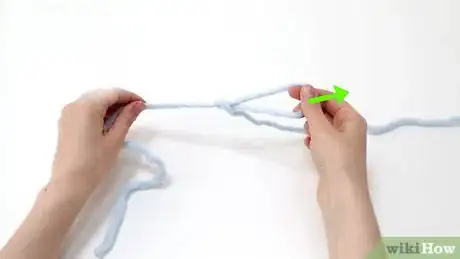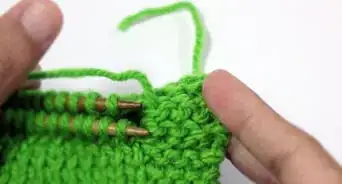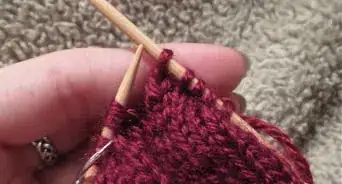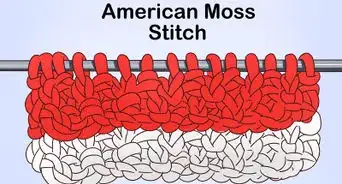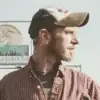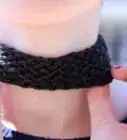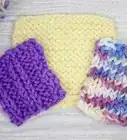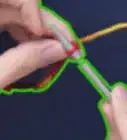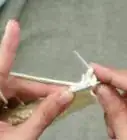This article was co-authored by Gregory Patrick. Gregory Patrick is a knitter who runs the popular blog Madman Knitting. He is also the author of the book "Mad Man Knitting or The Waiter and the Fly". He has been knitting and writing about knitting for over 10 years.
wikiHow marks an article as reader-approved once it receives enough positive feedback. This article received 12 testimonials and 95% of readers who voted found it helpful, earning it our reader-approved status.
This article has been viewed 379,590 times.
A cast on is a technique in knitting for creating the very first stitches of a project. A cable cast on creates a firm, beautiful edge that can be also be used to add stitches in the middle of a project.
The cable cast on is similar to the knit stitch, so it is a great skill for experienced knitters to learn. (Beginning knitters may want to learn the backwards loop cast on instead.) Keep reading to learn how to use this cast on.
Steps
-
1Make a slipknot.
- Make a loop in the yarn.
- Make another loop and pull it through this loop.
- Pull the slipknot tight.
-
2Place the slipknot on the needle and pull it snug.Advertisement
-
3Insert the right needle through the slipknot, as if to knit.
-
4Wrap the working yarn around the right needle as if you are going to knit.
-
5Work a knit stitch, but do not slip the stitch off the left needle.
-
6Bring the right needle up and place the stitch onto the left needle. Pull out the right needle. Now you will have two stitches on your left needle.
-
7Insert the right needle in between the two stitches on the left needle.
-
8Wrap the working yarn around the right needle.
-
9Pick up the wrapped yarn with the right hand needle and pull it through the two stitches.
-
10Bring the right needle up and place the stitch onto the left needle.
-
11Pull out the right hand needle. You should have three stitches.
-
12Repeat steps 7-11 until you created the appropriate number of cast on stitches, lightly tightening the stitches as you go along.
- You can make a small sample square of one inch to determine the number of stitches you should have.
- The number of stitches depends on the size of yarn you are using. For instance, a bulky or sport weight yarn will have fewer stitches than a fingering weight yarn.
- Another factor is tension or how tight or loose your stitches are when you knit.
Expert Q&A
-
QuestionHow can you prevent your knitting from curling at the bottom?
 Gregory PatrickGregory Patrick is a knitter who runs the popular blog Madman Knitting. He is also the author of the book "Mad Man Knitting or The Waiter and the Fly". He has been knitting and writing about knitting for over 10 years.
Gregory PatrickGregory Patrick is a knitter who runs the popular blog Madman Knitting. He is also the author of the book "Mad Man Knitting or The Waiter and the Fly". He has been knitting and writing about knitting for over 10 years.
Knitting Specialist You need not worry about curling at the bottom while knitting. After you finish knitting, you can block it. You should wet it and pin it flat to a blocking mat, then let it dry to get rid of curling.
You need not worry about curling at the bottom while knitting. After you finish knitting, you can block it. You should wet it and pin it flat to a blocking mat, then let it dry to get rid of curling. -
QuestionHow do you knit in the round?
 Gregory PatrickGregory Patrick is a knitter who runs the popular blog Madman Knitting. He is also the author of the book "Mad Man Knitting or The Waiter and the Fly". He has been knitting and writing about knitting for over 10 years.
Gregory PatrickGregory Patrick is a knitter who runs the popular blog Madman Knitting. He is also the author of the book "Mad Man Knitting or The Waiter and the Fly". He has been knitting and writing about knitting for over 10 years.
Knitting Specialist You have to use circular needles or a set of 4 or 5 double-pointed knitting needles to knit in the round. You can cast on the stitches as you do with straight knitting needles. After casting on, you should join the first stitch with the last stitch and begin your project working in the round instead of knitting back and forth.
You have to use circular needles or a set of 4 or 5 double-pointed knitting needles to knit in the round. You can cast on the stitches as you do with straight knitting needles. After casting on, you should join the first stitch with the last stitch and begin your project working in the round instead of knitting back and forth. -
QuestionHow do I cable cast on to the end of my knitting?
 MicheleTop AnswererCable cast on is perfect when you need to add stitches to a pattern. Simply insert your needle between the last two stitches and pull through a stitch, then place it on your needle just as you did when you first did the cable cast on.
MicheleTop AnswererCable cast on is perfect when you need to add stitches to a pattern. Simply insert your needle between the last two stitches and pull through a stitch, then place it on your needle just as you did when you first did the cable cast on.
Warnings
- The cable cast on takes longer than other methods and some find it tricky, but can be worth it for the firm edge.⧼thumbs_response⧽
- This is not for beginner knitters––don't use it until you've mastered the knit stitch. A better cast on for beginners is the backwards loop method.⧼thumbs_response⧽
Things You'll Need
- Knitting needles
- Knitting yarn
References
- Videos provided by WOOLANDTHEGANG
